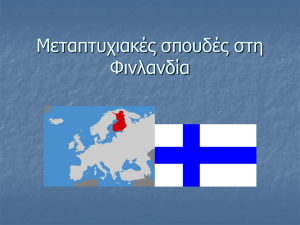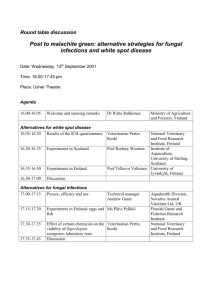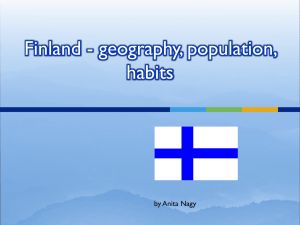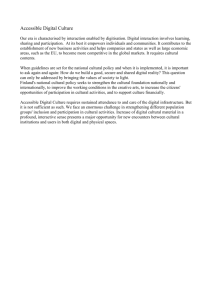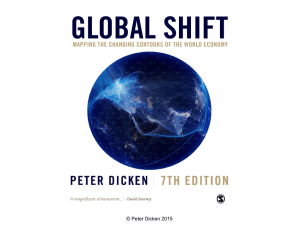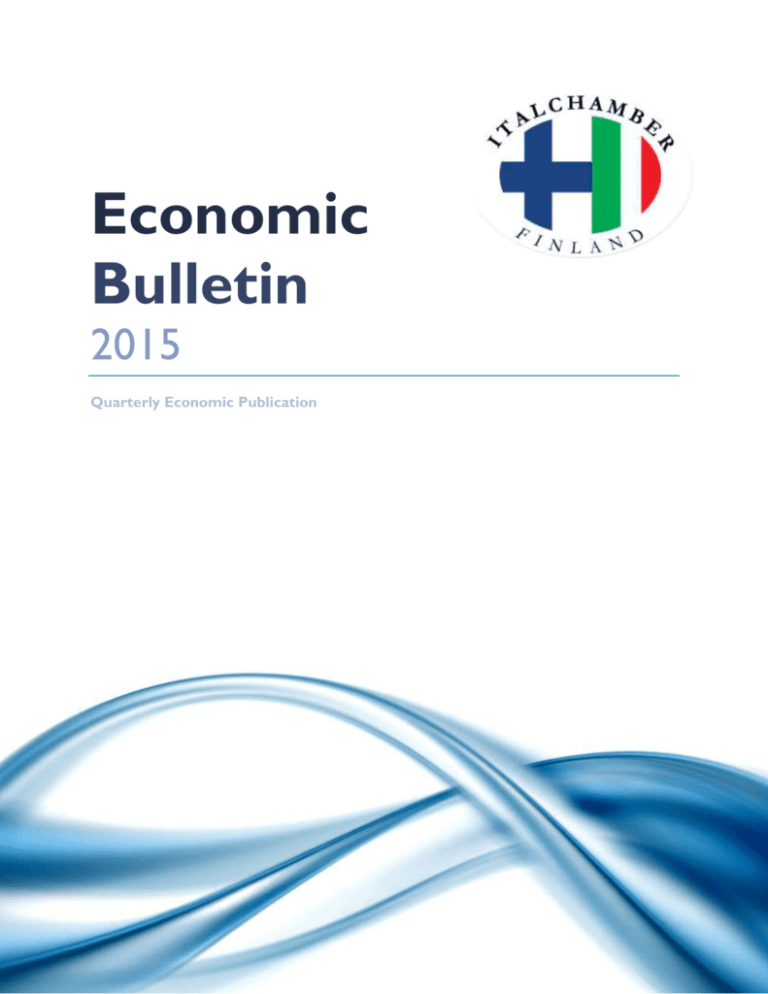
Economic
Bulletin
2015
Quarterly Economic Publication
The Economic Bulletin 2015 is published by Italchamber- Finland within
the activities of the General Secretariat of Italchamber Finland.
Pierre Collura
Head of the Editorial Board
SUOMALAIS-ITALIALAINEN KAUPPAKAMARIYHDISTYS RY
ITALCHAMBER – FINLAND
Copyright © 2015
By Italchamber Finland
All rights reserved. No part of this publication may be reproduced,
stored in a retrieval system, or transmitted, in any form or by any means,
electronic, mechanical, photocopying, or otherwise without the prior
consent of Italchamber Finland.
The Economic Bulletin is available at:
www.italchamber.fi
© ITALCHAMBER Finland
2
Table of Contents
Foreword ............................................................................................................................................................4
Best Wishes to President Mattarella ............................................................................................................5
EconomicSnapshot: Finland ............................................................................................................................6
Gross Domestic Product ...........................................................................................................................7
Inflation Rate .................................................................................................................................................8
Unemployment Rate ....................................................................................................................................9
Balance of Trade........................................................................................................................................ 10
EconomicSnapshot: Italy ............................................................................................................................... 11
Gross Domestic Product ........................................................................................................................ 12
Inflation Rate .............................................................................................................................................. 13
Unemployment Rate ................................................................................................................................. 14
Balance of Trade........................................................................................................................................ 15
Editorial ............................................................................................................................................................ 16
FINLAND 2015 ECONOMIC OUTLOOK ........................................................................................ 16
Tables ...................................................................................................................................................... 18
Featured Articles ........................................................................................................................................... 20
Single Supervisory Meachanism .............................................................................................................. 20
The function ........................................................................................................................................... 20
The membership ................................................................................................................................... 21
Sources: .................................................................................................................................................... 21
ITALY ECONOMIC OUTLOOK 2015 ............................................................................................... 22
Sources.................................................................................................................................................... 23
Fiera Milano: EventCalendar........................................................................................................................ 24
Fiera Milano: EventCalendar........................................................................................................................ 25
© ITALCHAMBER Finland
3
Foreword
I am delighted to present this second edition of the Economic Bulletin, edited by ItalchamberFinland.
The Economic Bulletin is a valuable instrument to monitor the main events concerning Finnish
and Italian business, financial and economic situation, providing some useful insights for an
introductory analysis.
Furthermore, the Economic Bulletin is also a visible sign of the increased commitment of
Italchamber-Finland to play a decisive role incontributing and providing support to the FinnishItalian commercial developments and deliver result to its business community. Among the
waste number of activities and initiatives recently played, I shall mention the recent creation of
an Italian stand at the Nordic Travel Fair (Matka). For the first time after several years,
Italchamber’s contribution has permitted an Italian participation to such commercial fair. Thanks
to Italchamber-Finland’s action, Expo Milan 2015 has joined the above fair as official exposer.
The above facts represent an objective evidence of the commitment of Italchamber-Finland’s
team to provide added-value.
I am sincerely thankful to the Editorial Board of Italchamberfor the valuable work done.
With kindest personal regards,
Avv. Dario Alessi
President of Italchamber-Finland
© ITALCHAMBER Finland
4
Best Wishes to President Mattarella
Da parte di Italchamber Finland auguri al di successo al Presidente Mattarella, che possa rappresentare
il momento della crescita economica e morale di un popolo unito dentro e fuori dall’Italia.
From Italchamber Finland we wish success to President Mattarella, may he represent the time of
economic and moral growth of a united nation within and outside of Italy.
© ITALCHAMBER Finland
5
EconomicSnapshot:
Finland
© ITALCHAMBER Finland
6
Gross Domestic Product
The volume of Finland’s gross domestic product increased in April to June by 0.2 per cent from
the previous quarter. Compared with the second quarter of 2013, GDP adjusted for working
days contracted by 0.1 per cent. The second quarter had one fewer working day than one year
previously.
In the third quarter, the volume of exports grew by 2.2 per cent from the previous quarter and
by 0.9 per cent year-on-year. Imports increased by 2.4 per cent from the previous quarter and
by 3 per cent year-on-year.
In the third quarter, the volume of private consumption went down by 0.3 per cent from the
previous quarter and by 0.2 per cent from twelve months back. Gross fixed capital formation,
or investments, grew by 0.5 per cent from the previous quarter but fell by 3.5 per cent yearon-year.
SOURCE: http://tilastokeskus.fi/til/ntp/2014/03/ntp_2014_03_2014-12-05_tie_001_en.html
© ITALCHAMBER Finland
7
Inflation Rate
The year-on-year change in consumer prices calculated by Statistics Finland was 0.5 per cent in
December. In November, it stood at 1.0 per cent. The inflation slowed down particularly
because prices of petrol and light fuel oil went down. In 2014, the average inflation rate was 1.0
per cent
In December, consumer prices were pushed up most from the previous year by risen rents,
increases in the retail prices of tobacco products, and price increases in maintenance services of
blocks of flats. The rising of consumer prices was curbed most in December by fallen prices of
liquid fuels, entertainment electronics and used cars from the year before. From November to
December, consumer prices fell by 0.1 per cent, primarily due to decreases in the prices of
liquid fuels.
SOURCE: http://tilastokeskus.fi/til/khi/2014/12/khi_2014_12_2015-01-14_tie_001_en.html
© ITALCHAMBER Finland
8
Unemployment Rate
According to Statistics Finland’s Labour Force Survey, the number of unemployed persons in
November 2014 was 215,000, which was 6,000 higher than one year ago. The unemployment
rate was 8.2 per cent, having been 7.9 per cent in November of the year before. There were
9,000 fewer employed persons than in November of the previous year. The number of persons
in disguised unemployment in the inactive population was 12,000 higher than one year earlier.
In November 2014, the number of employed persons was 2,422,000, which was 9,000 lower
than a year earlier (margin of error ±33,000). The number of employed persons decreased in
the private sector and grew in the local government sector compared with November 2013.
In November 2014, the employment rate, that is, the proportion of the employed among
persons aged 15 to 64, stood at 67.3 per cent, having been 67.8 per cent one year earlier.
Men’s employment rate was 68.0 per cent and women’s 66.6 per cent. Adjusted for seasonal
and random variation, the trend of the employment rate was 68.2 per cent.
SOURCE: http://tilastokeskus.fi/til/tyti/2014/11/tyti_2014_11_2014-12-23_tie_001_en.html
© ITALCHAMBER Finland
9
Balance of Trade
The value of Finnish exports decreased by six per cent and the value of imports decreased by
one per cent in November compared with the year before. The value of Finnish exports in
November was almost 4.5 billion euros and the value of imports was almost 4.6 billion euros.
The trade balance showed a deficit of 115 million euros in November. Calculated from January
to November there was a deficit of 1.7 billion euros. Under the same period in the year 2013,
the balance of trade showed a deficit of over 1.8 billion euros. In 2013 the trade balance for
November had a surplus of 121 million euros.
Exports to EU member states decreased by six per cent in November while exports to non-EU
countries also decreased by six per cent. Imports from EU-countries decreased by three per
cent while imports from non-EU countries increased by two per cent. Calculated from the
beginning of the year, exports to EU increased by four per cent, but decreased to non-EU
countries by seven. During the same period imports from EU member states rose by two per
cent, but from other countries imports fell by four per cent.
SOURCE:
http://www.tulli.fi/en/releases/ulkomaankauppatilastot/tilastot/ennakko/201411/index.html?bc=5
555
© ITALCHAMBER Finland
10
EconomicSnapshot:
Italy
© ITALCHAMBER Finland
11
Gross Domestic Product
388000
387500
387000
386500
386000
385500
385000
384500
384000
383500
2013 I
II
III
IV
2014 I
II
III
In the third quarter of 2014 the seasonally and calendar adjusted, chained volume measure of
Gross Domestic Product (GDP) decreased by 0.1 per cent with respect to the second quarter
of 2014 and by 0.5 per cent in comparison with the third quarter of 2013.
Compared to the second quarter of 2014, final consumption expenditure remained stationary,
gross fixed capital formation decreased by 1.0 per cent and imports by 0.3 per cent, while
exports increased by 0.2.
With respect to the third quarter of 2013, final consumption expenditure increased by 0.4 per
cent and exports by 1.3 per cent, while gross fixed capital formation decreased by 3.1 per cent
and imports by 0.7 per cent.
SOURCE: http://www.istat.it/en/archive/140558
© ITALCHAMBER Finland
12
Inflation Rate
108,0
107,8
107,6
107,4
107,2
107,0
106,8
Index b=100
106,6
106,4
106,2
January
February
March
April
May
June
July
August
September
October
November
December
January
February
March
April
May
June
July
August
September
October
November
December
106,0
2013
2014
In November 2014, the Italian consumer price index for the whole nation (NIC) declined by
0.2% compared with the previous month and rose by 0.2% with respect to November 2013
(0.1 higher than in October 2014). The flash estimate was confirmed.
The inflation registered a speed-up which was mainly due to the reversal of trend of
Unprocessed food prices (+0.8%, from -0.2% in October 2014); to a lesser extent,
contributions derived from other product typologies. This dynamics was partially offset by the
widening of the annual decrease of prices of Non-regulated energy products (-3.1%, from -2.2%
in the previous month).
Excluding unprocessed food and energy, core inflation was stable at 0.5% whereas, excluding
energy, the inflation was 0.6%, up from 0.4% in October 2014.
The annual rate of change of prices of Goods was -0.4% (from -0.3% observed in October
2014) and the annual rate of change of prices of Services was 0.9%, up from 0.7% registered in
the previous month. As a consequence, the inflationary gap between Services and Goods
increased by 0.3 percentage points with respect to October 2014.
Core inflation measured by Italian HICP was stable at 0.5% and the inflation calculated excluding
energy, food, alcohol and tobacco was stable at 0.6%. Excluding energy, the inflation rose to
0.6% (from 0.4% in the previous month) instead.
SOURCE: http://www.istat.it/en/archive/145134
© ITALCHAMBER Finland
13
Unemployment Rate
13,6
13,4
13,2
13
12,8
12,6
12,4
12,2
2013
November
October
September
August
July
June
May
April
March
February
January
December
November
12
2014
In November 2014 22.310 million persons were employed, -0.2% compared with October
2014. Unemployed were 3.457 million, +1.2% with respect to the previous month.
Employment rate was 55.5%, -0.1 percentage points with respect to October 2014,
unemployment rate was 13.4%, +0.2 percentage points over the previous month, and inactivity
rate was 35.7%, unchanged over October.
Youth unemployment rate (aged 15-24) was 43.9%, +0.6 percentage points in a month, youth
unemployment ratio in the same age group was 12.2%, +0.3 percentage points over the
previous month.
SOURCE: http://www.istat.it/en/archive/144199
© ITALCHAMBER Finland
14
Balance of Trade
40000,00
38000,00
36000,00
34000,00
32000,00
30000,00
28000,00
Exports (€ mil)
Imports (€ mil)
26000,00
24000,00
22000,00
20000,00
Istat presents data on Italy's foreign trade as well as unit value and volume indices (base year
2010=100) referring to October 2014.
In October 2014 seasonally-adjusted data, compared to September, increased by 0.4% for
outgoing flows and decreased by 0.9% for incoming flows. The growth in exports is the
synthesis of an increase for EU countries (+1.8%) and a decrease for non EU countries (-1.2%).
Imports decreased for EU countries (-0.7%) and non EU countries (-1.1%). Over the last three
months, seasonally-adjusted data, in comparison with the previous three months, increased by
1.2 for exports and decreased by 0.4% for imports.
In October 2014, compared with the same month of the previous year, trade increased by 2.9%
for exports (+4.7% for EU area and +0.8% for non EU countries) and decreased by 1.6% for
imports (+3.1% for EU and -7.7% for non EU countries). The trade balance in October
amounted to +5.4 billion Euro (+1.4 billion Euro for EU area and +4.0 billion Euro for non EU
countries)
© ITALCHAMBER Finland
15
Editorial
FINLAND 2015 ECONOMIC OUTLOOK
By Gianfranco Nitti
Winter is upon us, and most of us need an extra dose of vitamins. Metaphorically speaking, this
is also the case for large parts of the world economy where the economic performance has
again made the bank Nordea revise down the expectations in their fresh economic forecasts.
One such dose of vitamins could be the recent dramatic and unexpectedly sharp oil price
decline which could become a crucial catalyst for growth in the world economy, which we
expect to gain strength in coming years.
“Given the relatively weak international trends, growth conditions have been tough for the
Nordic countries, which are all quite reliant on foreign trade. Nonetheless, both Sweden and
Norway have delivered relatively decent growth rates, not least driven by a strong upturn in
domestic demand while Denmark and Finland have been the laggards in the Nordic growth
race. This will not change in the years ahead where we expect overall growth in the Nordic
region to rise from 1.4% this year to 1,9% in 2016”, says Helge J. Pedersen, Nordea’s Global
Chief Economist.
Finland is still stuck in recession. The slowdown in Russia hits the Finnish economy harder
than the other Nordic countries, and in light of the serious structural problems that Finland is
also struggling with, Nordea sees a risk of new growth disappointments.
From OECD
According to OECD forecasts, output is set to contract for the third year in a row in 2014.
Rising unemployment and mounting uncertainties are undermining business and consumer
confidence.
Fiscal tightening is also weighing on economic activity. The upturn in both domestic and foreign
demand is projected to be slow, as subdued income growth holds back consumption, global
growth remains sluggish and ample spare capacity delays a pick-up in investment.
© ITALCHAMBER Finland
16
The implementation of the government’s structural reform programme to increase labour force
participation and public sector efficiency is critical to ensuring fiscal sustainability over the
longer term, as age-related spending increases.
According to ETLA, Research Institute of the Finnish Economy, the euro area recovery is slow
and Finland’s GDP will grow by 0.8 per cent in 2015. Here’s its summary:
The world economy will grow slowly in the near future
Rapid growth in emerging economies is subsidizing, the US is the main engine of world growth
The euro area is recovering slowly, the Russian economy is falling into a slump and the
Ukrainian crisis is creating uncertainty
Finland's GDP will contract by 0.4 per cent in 2014 and grow by 0.8 per cent in 2015
The volume of exports is expected to grow by a couple of per cent in 2015
Private consumption will start to grow in 2015 by a half per cent fuelled by an upturn in
consumer confidence and employment
Private investment will start to increase by a couple of per cent in 2015 in the wake of a
recovery in demand
The unemployment rate rose to 8.7 per cent in 2014 and remains at that level also in 2015
The general government deficit relative to GDP will remain below the three per cent ceiling, but
the debt ratio will climb above 60 per cent
President of the European Central Bank Mario Draghi visited Finland at the end of November
2014 and gave a speech to the Finnish Parliament and at the Helsinki University.
In his speech at the Finnish Parliament, President Draghi highlighted that, over the past crisis
years, the ECB has acted forcefully to safeguard price stability and to contribute to financial
stability in the euro area as a whole. In particular, the ECB has taken several non-standard
measures to ensure the transmission of its monetary policy to the economy. The latest
unconventional measures announced by the ECB (the targeted long term refinancing operations
(TLTROs), and the covered bond and ABS purchase programmes) will have a sizeable impact
© ITALCHAMBER Finland
17
on our balance sheet, which we expect to move towards its early 2012 dimension. This will
ensure the necessary degree of monetary accommodation and contribute to a gradual recovery
and a return of inflation to levels closer to below, but close to, 2%. If, however, it becomes
necessary to further address risks of too prolonged a period of low inflation, the Governing
Council is unanimous in its commitment to using additional unconventional instruments within
its mandate.
Accountability and transparency are the essential elements balancing the independence of a
central bank, especially in times where unconventional measures are being taken. The ECB
regularly publishes a variety of data on the execution of monetary policy operations and the
liquidity conditions of the Eurosystem. (i.e. the SMP, the Covered Bonds Programmes and the
ABS Purchase Programme portfolios). Additionally, the Governing Council committed to the
publication of an account of monetary policy discussions.
As regards fiscal policy and structural reforms, while the Stability and Growth Pact should
remain the anchor for confidence in sustainable public finances, a comprehensive strategy is
needed to put the euro area economy back on track. This involves further sharing of
sovereignty, i.e a leap forward from common rules to common institutions. The upcoming
report commissioned by the Euro Summit on the future of economic governance will present a
good starting point for further reflection.
Tables
Source, OECD, Nordea
© ITALCHAMBER Finland
18
Key forecast Finland
2011
2012*
2013*
2014F
2015F
2016F
Consumer priceindexchange, %
3.4
2.8
1.5
1.1
1.3
1.6
Wagelevelchange, %
2.7
3.3
2.4
1.3
1.1
1.7
Unemployment rate, %
7.8
7.7
8.2
8.7
8.7
8.5
Current account surplus, % of GDP
-1.5
-1.9
-2.0
-1.3
-1.6
-1.6
Industrial output change, %
3.2
-2.8
-3.0
-0.9
2.3
2.9
Euribor 3-month, %
1.4
0.6
0.2
0.2
0.2
1.1
EU27 countries, GDP change, %
1.6
-0.4
0.1
1.2
1.5
1.7
- EMU-countries
1.5
-0.7
-0.4
0.9
1.3
1.5
EU27 countries, change in CPI, %
3.1
2.6
1.5
0.5
1.1
1.5
EMU-countries1)
2.7
2.5
1.4
0.5
1.1
1.5
Finland’s EMU surplus, % of GDP
-1.0
-2.1
-2.3
-2.8
-2.5
-1.7
Finland’s EMU-debt, % of GDP
48.5
52.8
56.2
60.3
62.8
64.2
* preliminary
1) Harmonized index
Source: Statistics Finland, ETLA
© ITALCHAMBER Finland
19
Featured Articles
Single Supervisory Meachanism
The purpose of the Single Supervisory Mechanism (SSM) is to bestow upon the European
Central Bank (ECB) the powers to monitor the financial stability of banks located in
participating states, starting from the 4th November 2014. This mechanism is part of the efforts
directed to the strengthening of the Economic and Monetary Union (EMU). The proposal of a
Council Regulation establishing the SSM was developed by the European Commission during
the summer of 2012, and subsequently published on the 12th September 2012.
The Single Supervisory board consists of 23 members: 17 representatives of bank supervisors
of member states, plus one chairman, one vice-chairman and four ECB representatives. The
decisional process is designed so that the supervisory board drafts supervisory a decision, and
subsequently the formal one is to be taken by the Governing Council, the ECB’s ultimate
decision-making body.
The function
This monitoring regime is enacted by conducting stress tests on financial institutions and, in the
case the test identifies problems, the ECB has the power to intervene in order to rectify the
situation. The purpose of the stress test is to determine whether a credit institution has enough
capital to withstand the impact of adverse developments, such as a financial crisis. The stress
© ITALCHAMBER Finland
20
testused in the SSM was designed by the European Systemic Risk Board, in cooperation with
the National Authorities, the European Banking Authority (EBA) and the ECB. According to the
parameters of the test, banks are required to maintain a CET1 ratio of 8% under the baseline
scenario, while a minimum of a CET1 ratio of 5,5% under adverse scenario.
On the 26th October 2014, the ECB has published the first comprehensive supervision review,
which covered 130 of the most significant credit institutions of the Eurozone states. The
supervision report included: the results of an Asset Quality Review (AQR) and the assessment
of potential capital short falls under the baseline scenario and the adverse scenario.
The membership
Not all members of the EU will participate in the Single Supervisory Mechanism. The EU
Treatise bestows upon the ECB jurisdiction only over the Eurozone, hence it cannot enforce
measures in a non-Eurozone state. Therefore the participation is automatic for Eurozone
states, while non-Eurozone EU Members can enter a close cooperation agreement with the
ECB. As of the 3rd November 2014, no request to enter the close cooperation agreement has
been notified in line with the procedure ECB/2014/510. However, the ECB has received
informal expression of interest from a number of non-Eurozone EU Member states.
Sources:
http://ec.europa.eu/economy_finance/euro/emu/index_en.htm
http://ec.europa.eu/finance/general-policy/banking-union/single-supervisorymechanism/index_en.htm
http://europa.eu/rapid/press-release_IP-12-953_en.htm
http://europa.eu/rapid/press-release_MEMO-13-780_en.htm?locale=en
http://www.economonitor.com/blog/2012/09/first-the-governance-then-the-guarantees/
http://www.investopedia.com/terms/b/bank-stress-test.asp
https://www.bankingsupervision.europa.eu/home/html/index.en.html
https://www.ecb.europa.eu/ecb/history/emu/html/index.en.html
https://www.ecb.europa.eu/press/pr/date/2014/html/pr141026.en.html
© ITALCHAMBER Finland
21
ITALY ECONOMIC OUTLOOK 2015
According to the forecast published by the OECD in November 2014, Italy’s economy, after
the contraction occurred for most of 2014, is projected to regain its growth by mid-2015 and
advance further in 2016. The monetary policy support of the European Central Bank’s (ECB)is
expected to ameliorate financial conditions and improve a renewal of bank lending, which
should raise investment. The estimatedrecovery of Italy’s export market will also support a
stronger growth. Furthermore, fiscal policy will have a small impact 2015 from the overall
perspective, as tax reductionswill be offset by spending cuts. Moreover, the unemployment rate
will start to drop in 2016, but is forecasted to maintain its high levels, while wage gains look set
to remain modest.
In an attempt to support economic growth, the government has delayed fiscal consolidation and
has completed some steps in its comprehensive programme of structural reforms. The
extremely high public debt ratio poses a significant vulnerability, and as growth improves higher
tax revenues should be channeled entirely to deficit reduction.
According to Reuters, Italy is preparing to cut its economic outlook for 2015 and raise its
targets for the budget deficit. Furthermore, the economy will contract by 0.2 percent or 0.3
percent this year, compared with the current official forecast made in April for it to expand 0.8
percent. The target for the budget deficit, calculated as a percentage of gross domestic product
(GDP), will be raisedof 0.2 percent, from 2.6 to 2.8 percent, remaining at the same level as last
year and inside the European Union's 3 percent ceiling, the source said.
© ITALCHAMBER Finland
22
According both to the aforementioned release of the OECD and the Italian employers'
association Confindustria the forecast for eurozone's third largest economy will contract by 0.4
percent in 2015. Moreover, the revisions of the Treasury to its outlook will be much sharper expected GDP growth drops to around 0.5 percent from 1.3 percent.
In accordance with the relaxation of its fiscal stance, the Italian government is hoping to
postpone its commitment to achieve the goals for a balanced budget in structural terms adjusted for the business cycle and one-off factors - to 2016 from 2015.
The coalition of Matteo Renzi's government got some breathing space in regards of the public
finances when ISTAT – the national statistics bureau – revised up the level of GDP due to
methodological changes.
On the 16th January 2015, according to the Bank of Italy economic bulletin the forecast for
Italy's gross domestic product (GDP) growthfor the year2015got slashed to just 0.4% from an
earlier prediction of 1.3% while the budget measures which helped avoid an even deeper
recession got some praise. In its quarterly outlook, the central bank estimated that the
economy in 2014 lost 0.4% compared to one year earlier, and suggested matters could have
been considerably worse if not due to the budget measures that included programs to aimed to
stimulate growth which helped the country to avoid a prolonged recession.
Besides the cut to the economy’s growth outlook for 2015 from its July forecast, the Bank of
Italy stated that it expects in 2016 the economy should improve by 1.2%.However, for the
present moment, "considerable uncertainty remains" and a restart of business investments must
be encouraged if growth is to be achieved.
"The intensity of the recovery in investments will be crucial," the Bank of Italy stated. The
forecast is similar to others made recently.In late December, the Prime Minister Matteo Renzi
forecasted that GDP would likely average -0.4% in 2014 but added he was confident there
would be a turnaround in the year ahead.
In the aforementioned report, based on a continued sluggishness throughout this year, the
central bank warned that deflation will be a persistent problem –an issue that can be identified
also across the eurozone.
Sources
http://www.ansa.it/english/news/2015/01/16/bank-of-italy-slashes-2015-gdp-forecast-praisesgovt_b05d68f2-afa0-4beb-a193-ef7a9a6573a4.html
http://www.bancaditalia.it/pubblicazioni/bollettino-economico/2015-1/boleco_1_2015.pdf
http://www.oecd.org/eco/outlook/italy-economic-forecast-summary.htm
http://www.reuters.com/article/2014/09/25/italy-economy-idUSR1N0QW00A20140925
© ITALCHAMBER Finland
23
Fiera Milano: EventCalendar
FEBRUARY
Name
Schedule
MILANO UNICA
04/06 FEB 2015
Borsa Internazionale del Turismo (BIT)
12/14 FEB 2015
MIPEL - The Bagshow
15/18 FEB 2015
theMICAM
15/18 FEB 2015
MYPLANT & GARDEN
25/27 FEB 2015
SIMAC TANNING-TECH
25/27 FEB 2015
LINEAPELLE
25/27 FEB 2015
MIPAP
28 FEB - 02 MAR 2015
SUPER
28 FEB - 02 MAR 2015
MIDO
28 FEB - 02 MAR 2015
MARCH
Name
Schedule
MIFUR - International Fur and Leather Exhibition
03/06 MAR 2015
3DPrint Hub
05/07 MAR 2015
CARTOOMICS
13/15 MAR 2015
HOBBY SHOW
13/15 MAR 2015
FA' LA COSA GIUSTA!
13/15 MAR 2015
BIKE4ME
13/15 MAR 2015
MADE EXPO
18/21 MAR 2015
MILANO AUTO CLASSICA
20/22 MAR 2015
© ITALCHAMBER Finland
24
Fiera Milano: EventCalendar
FEBRUARY
Name
Schedule
Labquality Days 2015
05/06 FEB 2015
Vene 15 Båt
06/15 FEB 2015
easyFairs® Fastfood& Café &Ravintola 2015
25/26 FEB 2015
easyFairs® Myymälä& e- commerce Helsinki 2015
25/26 FEB 2015
MARCH
Name
Schedule
Fillari 2015
06/08 MAR 2015
GoExpo 2015
06/08 MAR 2015
ValtakunnallisetKuntoutuspäivät 2015
09/10 MAR 2015
Sairaanhoitajapäivät 2015
12/13 MAR 2015
ChemBio Finland 2015
18/19 MAR 2015
Kevätmessut 2015
26/29 MAR 2015
Lähiruoka&luomu 2015
26/29 MAR 2016
© ITALCHAMBER Finland
25
SUOMALAIS-ITALIALAINEN
KAUPPAKAMARIYHDISTYS RY
ITALCHAMBER – FINLAND
DARIO ALESSI
President
dario.alessi@italchamber.fi
ANNALISA FLORE
Secretary General
annalisa.flore@italchamber.fi
+358 40 4810855
MIRO DEL GAUDIO
Deputy-Secretary General
miro.delgaudio@italchamber.fi
+358 50 3527101
VITO RAVO
Public Relations
vito.ravo@italchamber.fi
+358 40 7725737
PIERRE COLLURA
Head of the Editorial Board
pierre.collura@italchamber.fi
Temppelikatu 4A
00100 Helsinki
Finland
Business ID: 1525267-3
VAT No: FI15252673
Reg. No: 84.240
Tel. +358 9 4281 7000
Fax. +358 9 494 113
Mobile +358 40 4810855
email: info@italchamber.fi
www.italchamber.fi
PETTERI VILJAKAINEN
VicePresident
petteri.viljakainen@italchamber.fi
MARKUS HAKALA
VicePresident
markus.hakala@italchamber.fi
© ITALCHAMBER Finland
26

